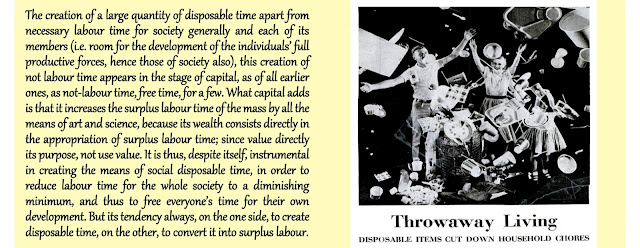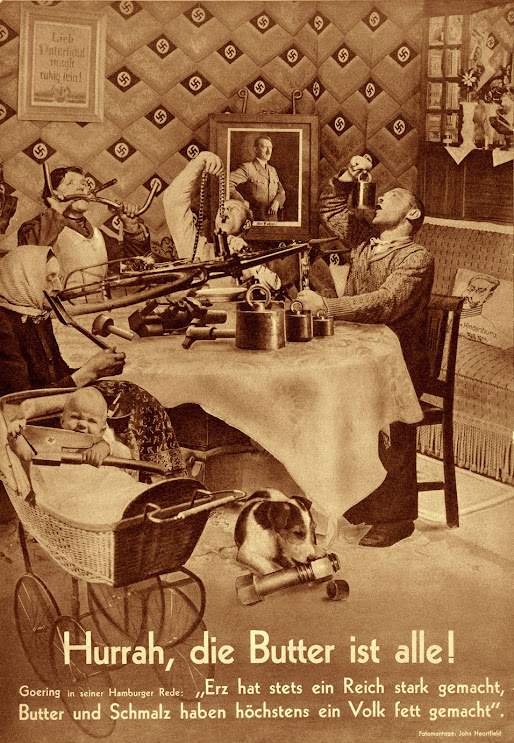Summary:
DISPOSABLE TIME, DISPOSABLE TIME, DISPOSABLE TIME, DISPOSABLE TIME, DISPOSABLE TIME, DISPOSABLE TIME, DISPOSABLE TIME... Did I mention "disposable time"? Marx repeated disposable time seven time in paragraph (three paragraphs in the complete works) I've taken the above excerpt from. In English. In capital letters. That, and the fact that his theory of crisis was sandwiched between two quotations from The Source and Remedy of the National Difficulty suggest to me that Marx's theory of crisis was a response to and elaboration upon the argument presented in the pamphlet.What Marx added was not commentary. It was a theoretical intervention of Biblical proportions, if you will pardon the expression. My argument would be that the contours of Marx's theory are more clearly defined against the
Topics:
Sandwichman considers the following as important:
This could be interesting, too:
DISPOSABLE TIME, DISPOSABLE TIME, DISPOSABLE TIME, DISPOSABLE TIME, DISPOSABLE TIME, DISPOSABLE TIME, DISPOSABLE TIME... Did I mention "disposable time"? Marx repeated disposable time seven time in paragraph (three paragraphs in the complete works) I've taken the above excerpt from. In English. In capital letters. That, and the fact that his theory of crisis was sandwiched between two quotations from The Source and Remedy of the National Difficulty suggest to me that Marx's theory of crisis was a response to and elaboration upon the argument presented in the pamphlet.DISPOSABLE TIME, DISPOSABLE TIME, DISPOSABLE TIME, DISPOSABLE TIME, DISPOSABLE TIME, DISPOSABLE TIME, DISPOSABLE TIME... Did I mention "disposable time"? Marx repeated disposable time seven time in paragraph (three paragraphs in the complete works) I've taken the above excerpt from. In English. In capital letters. That, and the fact that his theory of crisis was sandwiched between two quotations from The Source and Remedy of the National Difficulty suggest to me that Marx's theory of crisis was a response to and elaboration upon the argument presented in the pamphlet.What Marx added was not commentary. It was a theoretical intervention of Biblical proportions, if you will pardon the expression. My argument would be that the contours of Marx's theory are more clearly defined against the
Topics:
Sandwichman considers the following as important:
This could be interesting, too:
Robert Vienneau writes Austrian Capital Theory And Triple-Switching In The Corn-Tractor Model
Mike Norman writes The Accursed Tariffs — NeilW
Mike Norman writes IRS has agreed to share migrants’ tax information with ICE
Mike Norman writes Trump’s “Liberation Day”: Another PR Gag, or Global Reorientation Turning Point? — Simplicius
What Marx added was not commentary. It was a theoretical intervention of Biblical proportions, if you will pardon the expression. My argument would be that the contours of Marx's theory are more clearly defined against the contrast of the 1821 pamphlet's argument. But the influence of The Source and Remedy on this breathtaking passage about the creation of disposable time from the Grundrisse is unmistakable. "The creation of a large quantity of disposable time..." echoes Marx's earlier statement that the "whole development of wealth rests on the creation of disposable time" and thus ties the third fragment on machines unequivocally to the first fragment, as do the centering of surplus population and the juxtaposition of the superfluous and the necessary.
The image, from a 1955 LIFE magazine feature, celebrated the emancipation of family members from household chores that disposable goods provided. It unintentionally evokes the anti-Nazi photomontage by John Heartfield, "Hurrah, die Butter ist alle!"


